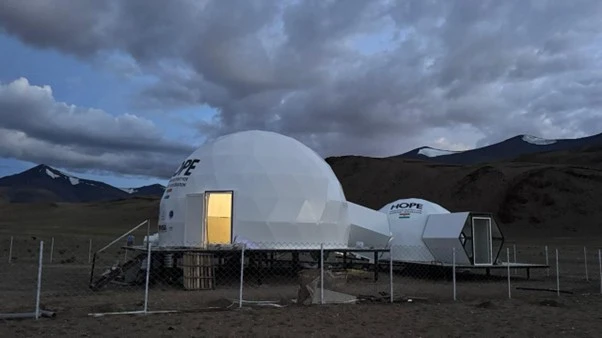| Summary |
|
India’s dream of sending astronauts to the Moon is taking a big step forward in the rugged, high-altitude desert of Ladakh. On August 1, 2025, the Indian Space Research Organisation (ISRO) inaugurated the Himalayan Outpost for Planetary Exploration (HOPE), a facility designed to mimic life on Mars or the Moon.
Located 4.3 kilometers above sea level in Tso Kar Valley, the HOPE facility is built by Bengaluru-based Protoplanet with ISRO’s support. It includes an eight-meter habitat module for living and a five-meter utility module for operations. These interconnected units simulate the confined spaces astronauts might face on other planets.
The site’s extreme cold, low air pressure, high ultraviolet radiation, and salty permafrost mirror conditions on early Mars, making it an ideal spot for research.

“This analogue mission is more than a simulation; it is a rehearsal for the future,” said ISRO Chairman Dr. V. Narayanan at the inauguration. The facility will help scientists study how humans cope with isolation, stress, and physical challenges in space-like environments. This is critical for India’s plan to land astronauts on the Moon by 2040.
The 10-day HOPE mission, running from August 1 to 10, 2025, involves two crew members living in the habitat. Researchers from institutions like the Indian Institute of Space Science and Technology and IIT Bombay are studying their physical and mental responses. They’re testing everything from health-monitoring tools to microbial analysis, ensuring astronauts can stay healthy during long missions.
“This facility will be helping us mainly in the human spaceflight activities,” said Dr. V. Narayanan.
Ladakh’s harsh terrain isn’t new to space research. Last year, ISRO’s Human Space Flight Centre ran the Ladakh Human Analog Mission, followed by a 10-day isolation study in Bengaluru. These efforts are building significant data on how Indian astronauts handle space-like conditions, a key step for the Gaganyaan mission and a planned space station by 2035.
The project isn’t just about science. Protoplanet partnered with Mahindra Automobiles for mobility support and leaned on expertise from The Mars Society and Mars Society Australia, who’ve built similar facilities in deserts and the Arctic. This collaboration shows India’s space sector opening up to private players, a shift backed by Prime Minister Narendra Modi.
At a cost of just Rs 1 crore, HOPE is a budget-friendly way to prepare for space missions, compared to the Rs 550 crore spent on a 20-day International Space Station trip of Shubanshu Shukla. While it can’t simulate microgravity, the facility covers nearly every other aspect of extraterrestrial life. Dr. Narayanan plans to visit soon to see its potential firsthand.
India’s space ambitions are soaring, with eight new missions approved, including crewed missions like Gaganyaan. The HOPE facility is a vital piece of this puzzle, offering a glimpse into what it takes to live on another world.

